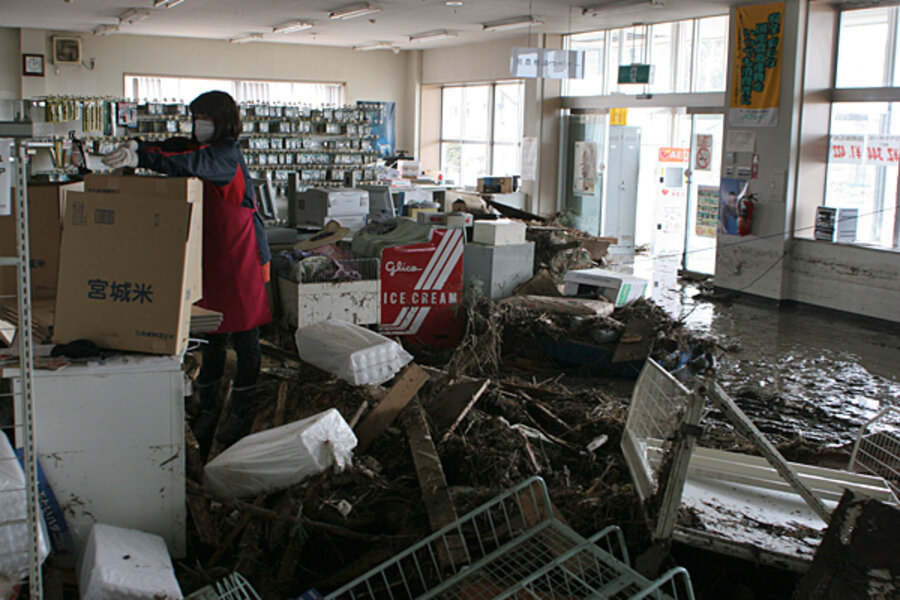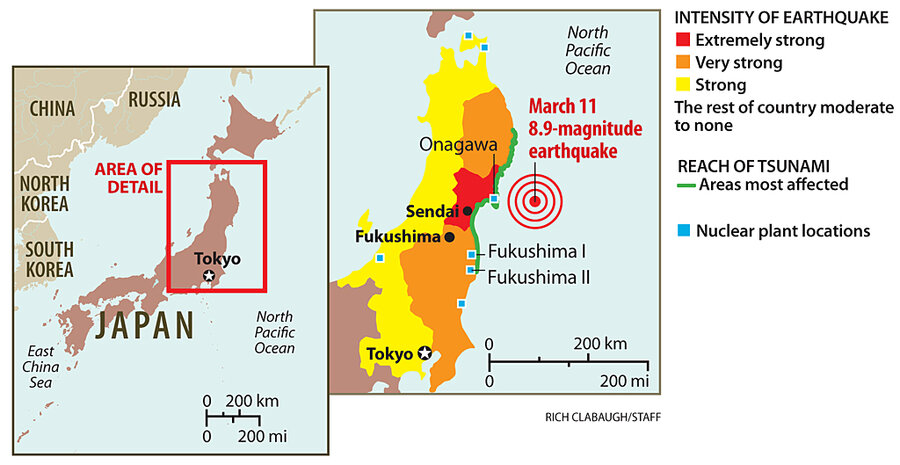Japan earthquake: Survivors dig out, return to work
Loading...
| Yamamoto, Japan
Toshiyo Shishido found it hard to know where to start when he returned Monday morning for the first time since the tsunami to the agricultural supply store that he manages in this coastal village.
The forecourt was torn up and piled with tree trunks, random timber, and a roof that the giant wave had dislodged from its house. A truck lay on its side around back. Inside the front door, smashed by a tree, the floor was coated with thick mud beneath waist high debris.
Armed with a chainsaw, a forklift truck, and shovels, Mr. Shishido’s employees were shifting the mess on Monday, wheelbarrow load by wheelbarrow to the roadside, in a first tentative effort to recover from the disaster that has ravaged large swathes of Japan’s northeastern coastline.
A 8.9-magnitude earthquake rocked northeast Japan on March 11, prompting a tsunami that sent 30-foot waves miles inland along the country's northeast coast and destabilized the Fukushima nuclear plant. Officials say the death toll from the earthquake and the tsunami is likely to hit at least 10,000. Survivors have begun to dig out their homes and businesses and begin to look for ways to rebuild their lives.
Clearing the debris
Most business is still at a standstill the length of the coast hit by the tsunami; residents are still emerging from shock, shops are closed for lack of supplies, and much of the region is without electricity, water, and gasoline.
Others in Sendai were doing grim work. At the port, totally devastated by the tsunami, firemen from all over Japan were combing the wreckage for bodies; the time for finding survivors, they said, has passed.
They clambered up piles of crazily stacked vehicles, peering through broken windows. They picked through the mad assortment of detritus that the tsunami left behind, countless lives and businesses reduced in minutes to so much flotsam and jetsam.
In just one patch of a few square feet were scattered a pile of dried peas, a coil of clear plastic hosepipe, a wooden pallet, a bundle of sacks, a table, two tires, a carton of detergent, a gas cylinder, a car tipped against a tree, a mattress, two packs of kitchen towels, and a refrigerator without its doors. A little further away lay a kitchen sink.
Mr. Shishido's simple, if daunting, task of clearing out the debris around his store seemed to act as an antidote to the pain he felt as he surveyed the destruction around him: Half his village flattened, untold neighbors missing, and the surrounding rice paddies rendered barren by salty seawater. But he was still stunned.
“I cannot think,” he says. “I just want time to go backwards. I want the things we used to have back.”
Fridge righted, dishes piled in a corner
The Shirasaki family share that dream, but worry it may be vain.
On Monday afternoon they were making a start on clearing out the house they built three years ago, now scarred by a tidemark eight feet up the walls testifying to the height of the wave that swept through their home.
Inside, Mari Shirasaki had begun to impose the first semblance of order on the chaos that the tsunami had left in its wake. Crockery was piled in a corner on the muddy floor, the refrigerator had been righted, and salvageable cans and bottles had been packed in cartons.
Outside her husband Yasahiro was nailing blue tarpaulins where French windows had once graced his small two-story home next to the port in Sendai, while their two young sons amused themselves by collecting some of the thousands of cans of beer strewn all over their street.
“I hope we’ll live here again but I’m afraid it may not be possible,” Mrs. Shirasaki sighs. “I think the seawater may rot the walls. All we’ll be left with are our mortgage payments.”
Truck driver salvages DVDs, but little else
Keiji Sakuma and his wife Natsuko have been left with even less. They had returned to salvage what they could from the wreckage of their home in Sendai but soon been told to leave by firemen because the structure was likely to collapse. Mr. Sakuma carried a sodden pouch of DVDs for his daughter. His wife had rescued only her most precious keepsake – her child’s umbilical cord.
A truck driver for a transport company based in Sendai port, Mr. Sakuma is now idle. “I don’t know when I’ll get my job back, or even if I will,” he says. “My boss has not called me.”
Back in Yamamoto, Shishido fears it may take months before he is back to selling fertilizer and farm equipment from his cooperative store. “But we have to rebuild,” he says. “It’s the duty of those of us who are left.”






